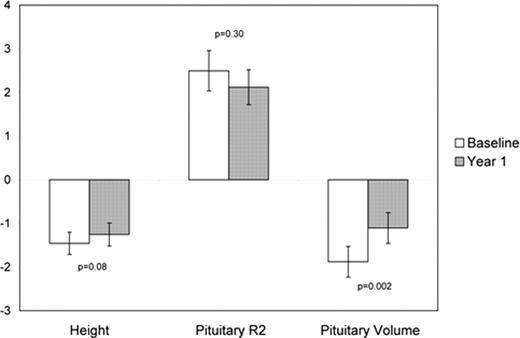Abstract
Abstract 5161
The relationship between organ iron overload and clinical toxicity in chronically transfused patients is not completely understood. Given that hypogonadotropic hypogonadism (HH) is the most common endocrine problem in chronically transfused patients, it is important to qualify the effects of pituitary iron overload. MRI can image preclinical pituitary iron deposition, similar to its use in the heart, liver and pancreas. Increased pituitary R2, a surrogate for iron, and decreased pituitary volume predict clinical and biochemical HH in iron overloaded adults 1,2. However, data regarding pituitary iron deposition and its effect on pituitary growth in the pediatric population is lacking. In addition, the effect of chelation therapy on pituitary iron and volume over time is unknown. We present first year results from a two year observational trial of changes in pituitary R2 and volume in response to deferasirox therapy in patients with transfusional siderosis.
We report 16 chronically-transfused patients with Thalassemia Major and one patient with Diamond Blackfan Anemia studied over a one year period. All patients were on deferasirox for at least 6 months prior to start of study; drug dosing was determined by the patient's physician and was independent of the research study. The average age at the final exam was 14.1 ± 5.2 years (range: 5.1–24.6 years). All studies were performed on a 1.5 T Philips Achieva. Anterior pituitary R2 was assessed in the sagittal and coronal planes using multiple spin echoes from 15 to 120 ms. Pituitary volume was assessed using a 3D spoiled gradient echo sequence with 1 mm3 isotropic voxels. Pituitary R2 was calculated by pixelwise monoexponential fit, with median values used to represent the overall gland R2; boundaries were confirmed by a board-certified neuroradiologist. Normative data for pituitary iron and volume was drawn from another study in 100 normal volunteers. Patient height, pituitary R2, and pituitary volume were all expressed as age corrected Z-scores. MRI estimates of hepatic iron concentration (HIC), cardiac iron (T2*), and pancreatic iron (R2*) were obtained as clinical standard of care. All statistics were performed using JMP5.1 (SAS, Cary, NC).
Patients were mild to moderately iron overloaded with HIC of 6.7 ± 6.9 mg/g dry weight, cardiac T2* of 31.3 ± 7.8 ms, and pancreas R2* of 117.2 ± 128.7 Hz at the beginning of the study. These results were not yet available for the one year follow up. Ferritin values were available for 16/17 of the patients at both baseline (1346.9 ± 1479.5 ng/mL) and year one visits (1102.2 ± 1074.0 ng/mL, p=0.24). Change in ferritin did not correlate with change in pituitary R2. Median sagittal measurements of pituitary R2 were 13.7 ± 1.9 Hz (baseline) and 13.4 ± 1.7 Hz (year one). An improvement was seen in average Z-score for patient height and in average Z-score for anterior pituitary volume. There was no correlation between the change in Z-score for height and the change in Z-score for pituitary volume. Figure 1 summarizes the average Z-scores for height, pituitary volume, and pituitary R2 at baseline and at year one; p-values reflect paired statistics.
The present data suggest that deferasirox monotherapy stabilizes pituitary iron levels and facilitates normal pituitary and somatic growth in children and young adults. Although reductions in pituitary R2 Z-score did not reach statistical significance, the favorable glandular and somatic growth responses suggest that deferasirox is successfully detoxifying glandular iron. Although encouraging, these data are limited by small sample size and short follow-up; two-year data will provide more robust estimates of treatment efficacy and predictors of response.
1. Argyropoulou MI, Metafratzi Z, et al. AJR Am J Roentgenol. 2000;175:1567-1569.
2. Argyropoulou MI, Kiortsis DN, et al. Neuroradiology. 2001;43:1056-1058.
Coates:Novartis: Research Funding, Speakers Bureau. Wood:Novartis: Consultancy, Research Funding, Symposia speaker.
Author notes
Asterisk with author names denotes non-ASH members.


This feature is available to Subscribers Only
Sign In or Create an Account Close Modal